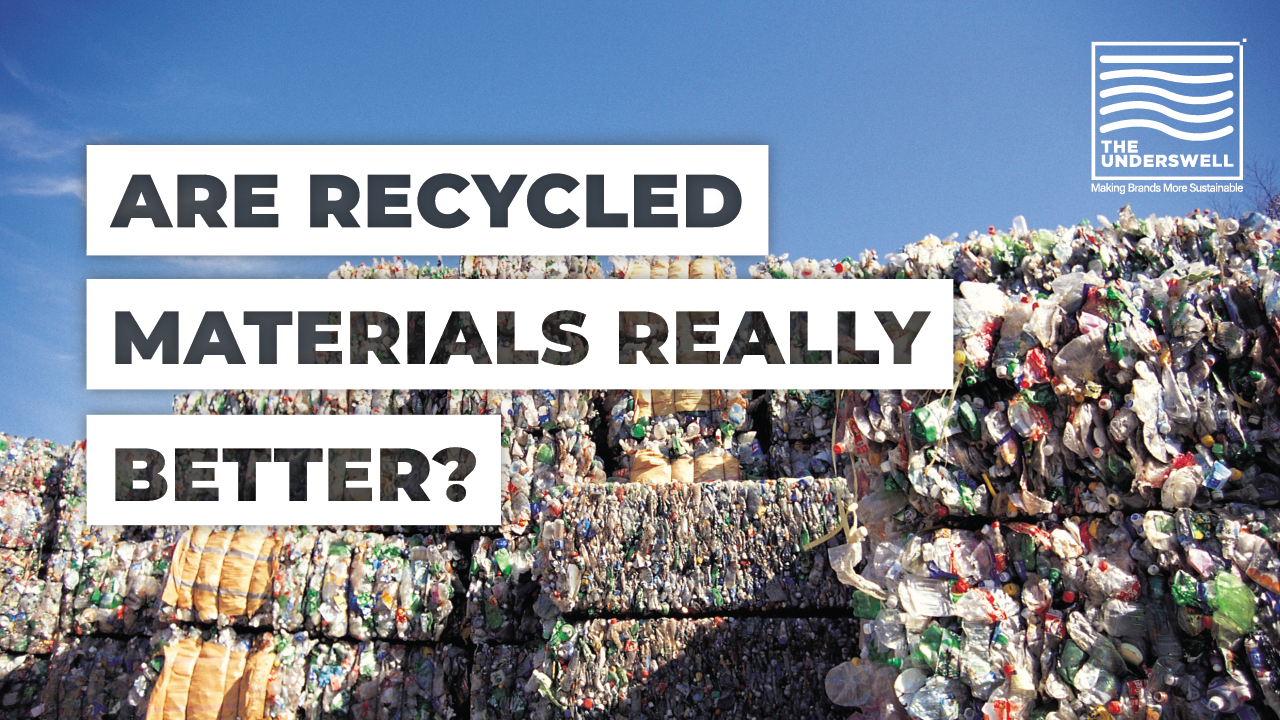Are Recycled Materials Really Better?
Dec 01, 2022
When we talk about preferred materials, there are a lot of people out there who promote recycled materials as “more sustainable” or “eco-friendly,” but is that really the case?
The answer is a lot more complicated than many of us were hoping for, but that’s the name of the sustainability game - nothing is ever easy!
Recycled materials are considered a preferred material and that’s because it’s typically a better alternative to conventional options. But before we get into all of that, make sure you watch our YouTube video on this same topic. If you have any thoughts or questions, make sure you leave them in the comments section!
When we’re trying to assess if a recycled material is more sustainable, we first have to make sure we’re making the right comparison. For example, we don’t really want to compare recycled polyester to organic cotton - we need to be using a 1-to-1 (or apples-to-apples as they say) comparison. Instead, let’s look at recycled polyester compared to virgin polyester or recycled cotton to conventional cotton. There is data available to help you understand the land, water, emissions, and other impacts associated with both, but without getting too stuck in the weeds, we recommend reading this McKinsey report. They’ve done a great job of breaking down a few simple actions and tying them to climate impacts.
We also have to consider where the recycled inputs came from. We can get these inputs from two different waste streams, either post-industrial waste (things like fabric scraps) or post-consumer waste (finished goods). Unfortunately, there aren’t any scaled post-consumer textile recycling facilities out there (although, shout out to Renewcell, that feels like it’s about to change), so we have to largely rely on post-industrial waste. However, there is even more we have to consider when looking at recycled materials…
There are two different types of systems for recycled materials - closed-loop and open-loop systems. To keep things simple, let’s go back to our example of polyester. In a closed-loop system, water bottles made from PET would be recycled and turned into new water bottles. In an open-loop system, like the one we have now, water bottles are collected, recycled, and turned into fiber for the apparel industry.

This may not seem like that big of a deal because hey, at least the plastic is being reused! Well, it’s more complicated than that… We’ll do a whole separate post on closed-loop vs. open-loop recycling in the future, but for now, let’s focus on the topic at hand.
Not only do we have to consider where our recycled materials came from, but we also have to think about how they were recycled. There are two different ways to recycle materials - mechanically or chemically. When using mechanical recycling, we need to consider the energy consumption needed to fulfill the recycling process and whether renewable energy was used at all in the process. Recycling, just like any other energy intense process, will produce emissions if not done efficiently! Using the chemical process, we have to think about what chemicals were used and how they were disposed of.
Again, it all gets pretty complicated and detailed, so we’re simplifying the process.
Stick with us - we also have to think about the environmental impact that recycled materials can have. On one side, using recycled materials practically eliminates a whole tier from the supply chain. When recycled polyester or cotton is used, we no longer need that raw material extraction phase of the supply chain. That means fewer fossil fuels and fewer soil impacts. On the other hand, using recycled materials doesn’t eliminate all of our issues. Microfiber release, emissions, and water consumption are still issues tied to recycled materials. Like we said above, there is no easy answer.
So what are the pros and cons of using recycled materials? I’m glad you asked:
Pros
- Typically, recycled materials have less energy and water consumption than their conventional counterparts
- Recycled materials are typically cost-effective for most brands
- This is an easy-to-understand marketing message for consumers
Cons
- Traceability is lacking and it’s hard to verify recycled content
- The fiber is sometimes weaker than virgin materials, making it less durable over time
- Made with recycled inputs doesn’t make it “recyclable”
While there are plenty of other pros and cons associated with recycled materials, we think this is a good place to start when trying to make your decision on recycled materials.
And if you’re still wondering if recycled materials are really better, you probably won’t be surprised to hear our favorite answer - it depends! Whatever is best for your brand, we know you guys will make the best decision.
If you have any questions about today’s topic or have a suggestion for future topics, email us at [email protected] and don’t forget to stay connected with us on Instagram and LinkedIn!
Thanks,
McKenzie
#keeplearning #recycling #preferredmaterials #sustainablefashion
